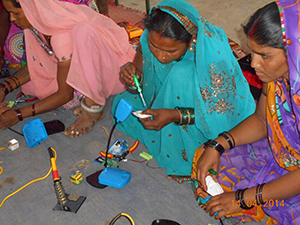
1. Testing of components: All the components are inspected for any physical damage. The battery, LED and the PCB panel are also subject to technical tests. The good components continues for assembly, and the faulty/ damaged components are returned to and exchanged with the suppliers.
2. Assembly of the Lamp: This is a multi-step process wherein all the components are assembled to produce the solar lamp, SoUL. The number of components in one lamp ranges from 18-25 (depending on the supplier). The assembly process ranges from simple operations such as screwing in the covers, to the skilled operation of soldering lead wires to the PCB. Proper procedure and importance of soldering is taught to all assemblers. The assembly process also involves intermediate testing of sub-assemblies. Each assembled lamp is assigned a unique code.
3. Final SoUL testing: The final assembled solar lamp is tested to ensure that it is working as per specifications.
4. Packaging: The solar lamp is packed in cardboard boxes, along with the instruction manual.
It is ensured that all assembly centers at all locations follow the assembly guidelines meticulously. The division of labour and number of persons assigned to perform each task may vary across centres.

The distribution involves two equally important aspects:
1. Selling of the solar lamp: It is ensured that only 1 lamp is sold to a school child at the subsidized price of Rs.120. This is to ensure that every child (i.e. million school children) get a lamp each for their own use. The details of the sales (with details of the child, and school) are recorded in a Distribution Information Sheet. This acts a common receipt to the NGO, the school and IIT Bombay.
2. Baseline data collection: Basic information of every receipt is recorded, such as name and address, school details, their current source of electricity at home, and study habits. This data will be used in future to (i) periodically assess the impact of SouL, and (ii) set up the repair and maintenance facilities.

